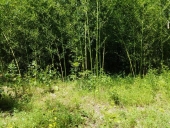posted 12 years ago
Hey Miles:
Thanks for the welcome -- I am definitely excited to have this conversation, and especially to look at the forest farming vs forest gardening question.
There are many lines that we can draw in the sand - but in my mind they are sometimes useful and sometimes no so much. When writing a book it is useful to contain your content a bit as you can quickly see the book getting bigger and bigger - which can water down the key concepts. So, my thinking is that for the sake of discussion and comprehension it is good to distinguish one thing from another - but in practice, especially in permaculture practice - hopefully the lines blur together.
So - to more directly answer your question - I (and others) define the two items as follows:
Forest Gardening = mimicking the structure and function of forests in the way we garden, aka using the forest as a model for the way we garden. Dave Jacke and others advocate that in Forest Gardening we want to mimic mid-succession forests - woodlands, even. It is here that the most layers of trees, shrubs, herbaceous plants, etc can thrive - and many of our multi-functional species are adapted to this phase of growth. As Dave Jacke has said, this is "gardening LIKE the forest".
Forest Farming = the intentional cultivation of non-timber forest crops underneath the established canopy of an existing forest. This is gardening/farming IN the forest. Since we are working with later successional eco-types, our palette of species is quite a bit more limited. Species need to be considerably more shade tolerant. We tend to focus more on things like mushrooms, and shade loving periennals that are already found in woodlands (ginseng, leeks, goldenseal, etc)
So, a basic distinction might be the type of system we are starting with - are we going from open field or brushy field and thinking about taking this toward a forested system, or are we working with expanding the diversity and functionality of an existing forest?
On our farm we have both options to work with. In the end, what is important to us is the use of tree-based agriculture as our driving design feature. We have a one acre, existing Sugar Maple grove we are managing as a mixed woodlot for maple sugaring, mushroom, ginseng, and other woodland medicinal production. We are then looking to bring the forest to the field - in the form of windbreaks, coppice fuel production, and restoring riparian corridors.
One last thought - then hope some others will chime in. The USDA defines agroforestry as the combination of trees and agriculture. They further distinguish several types of agroforestry:
- Forest Farming (as mentioned)
- Silvopasture (grazing animals under a forest canopy of about 50% cover, so that grasses can persist)
- Riparian Buffers (tree crop systems in waterways)
- Windbreaks (tree crop systems to buffer effects of wind)
- Alley Cropping (rows of trees in between conventional crops)
at Cornell, we have also added Forest Gardening (developing patches of multiple species and layers, mimicking forest structure and function)
Each serves to demonstrate a slightly different perspective on woody agriculture - but in the end achieve similar results. As we seek to creatively assemble these systems we can use each of these distinctions to aid out thinking. For instance, our farm design has a forest farming component (existing Sugar Maple woods). We plan to add a windbreak this year (multi-functional of course), and then develop patches of forest gardens (more intensive management) as well as a riparian zone. Silvopasture will be accomplished throughout, as we move our ducks and eventual sheep through ALL of the previously mentioned systems (except no sheep in the Maple woods.)
All for now....thanks!
Steve








